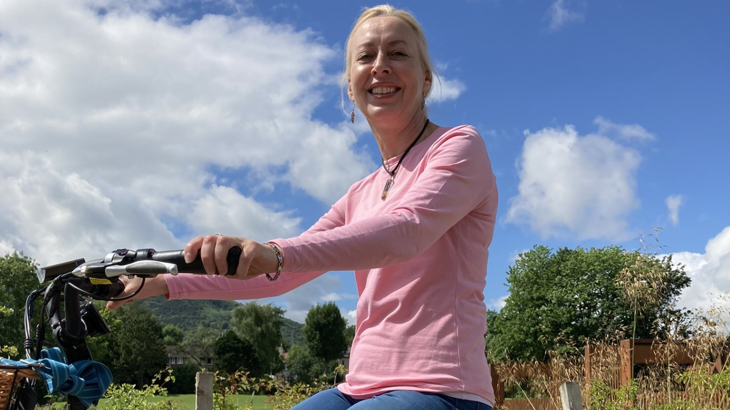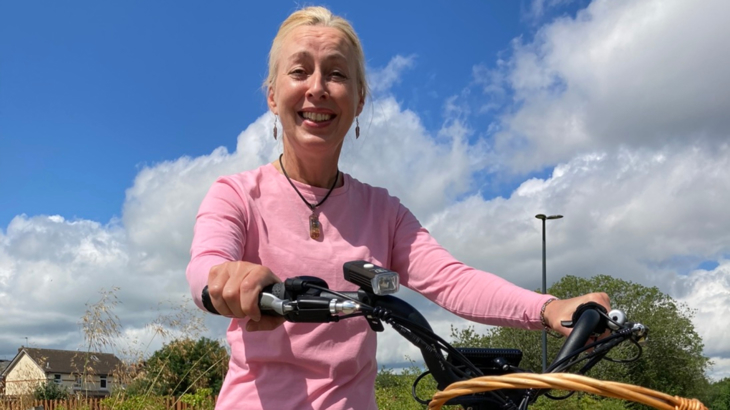Our latest Walking and Cycling Index has revealed that 61% of disabled people feel welcome and comfortable walking, wheeling[1] or spending time on the streets of their neighbourhood. For Joanne, who has cerebral palsy, getting out on her e-trike and socialising on traffic-free routes near her home gives her huge amounts of joy. Having access to fresh air and making connections has brought her out of a dark place to one where she is fully immersed in her local community.

Getting out on her e-trike and socialising on traffic-free routes near her home gives Joanne huge amounts of joy. Credit: Rachael Ludlow-Williams
Joanne, who lives in Belfast, was recommended cycling as a form of therapy to strengthen her back muscles after undergoing spinal fusion surgery.
She hadn’t cycled since she was a child, and it took some getting used to.
After her surgery she was given anti-depressants for pain relief which she took for nine years.
Within two months of investing in her own trike she felt she no longer needed to take her medication and hasn’t taken it since.
Joanne’s condition means she can often trip up when walking, but when she’s on her trike, it’s like “the cerebral palsy just disappears.” She said:
“I don’t feel as self-conscious on the trike as I do when walking.” She added:
“Looking back, I was very, very unhappy - life can really knock you down. I’m lucky to be out the other side.
“Since having my trike, I know I’ve always got something to fall back on when I’m in a low place.
“When I feel overwhelmed or anxious all I can think is ‘I need to get out on the trike.’
“I never used to think like that - the trike has done that for me. I’ve called it ‘Joy’, because that’s what it gives me.
“I can go out on my own and I feel safe. I get out into the fresh air, exercise, socialise and just take a minute to think about life – it helps clear my head.
“I come back home feeling happier and more content.
“The joy it brings me is second to none.
“My trike is my lifeline.”
A couple of years ago, Joanne, who has done cycle training with Sustrans, had the option of using either a trike or a mobility scooter to get around.
“Although I chose a trike, a mobility scooter is accepted as a mobility aid, whereas a trike is not.
“When I go to hospital appointments, I’m unable to take my trike inside, the way I could with a mobility scooter.
“It means I have to get a taxi to appointments.
“I think trikes should be considered mobility aids and there should be allowances.”
Choosing a trike has strengthened Joanne's muscles, allowed her to get into nature, and has done wonders for her social life.
When out on her local traffic-free routes, her trike is often a big talking point.
“My favourite thing about getting out on the trike is meeting people and chatting to them.
“Everyone knows me around here now as the lady on the trike.
“When I’m out on the trike no one sees my disability. It’s nice to not have people’s first impressions of me being the fact that I have a visible disability.
“I’ve met other people out and about who have cerebral palsy who are also interested in getting a trike - I let them have a trial of mine before they go ahead and buy one.
“I couldn’t ride the trike when I first got it and I thought ‘what have I done?’, so being able to give other people the opportunity to try one out is great.
“I wasn’t able to get out onto the Lagan Towpath without my e-trike – I wouldn’t have met half the people I’ve met. It’s allowed me to reconnect with nature as well.
“Since getting out on my trike I’ve formed a new friendship too.
“Freda stopped me one day when I was out and about and asked me about my trike.
“She now has one of her own and we’ve become cycling buddies.
“I was really in need of a friend at the time, I was in a dark place.
“Everything has worked out, things are meant to be.
“It really has been lifechanging for me.”

When it comes to wheeling in the road or on a wide footpath, Joanne will always choose the footpath as she feels like it’s the safer option. Credit: Rachael Ludlow-Williams
But it’s not always a walk in the park for Joanne.
Kissing gates are a real obstacle for her, and when it comes to wheeling in the road or on a wide footpath, she’ll always choose the footpath as she feels like it’s the safer option.
“Some of the roads around here could really do with the cycle lanes widening.
“At the moment you can only fit a standard bike in them.
“The lanes are about 12 inches wide – which makes it hard for people on trikes and mobility scooters to get around using the roads.
"I find the roads intimidating and avoid them if I can.”
Joanne is not alone in wanting more investment for wheeling and cycling in her area.
Our latest Walking and Cycling Index (2023) has found that more than half of people (56%) of people support shifting investment from road building to funding options for walking and wheeling, cycling and public transport.
“Belfast’s cycling infrastructure is improving all the time. It's come a long way recently which is great to see.
“I hope through sharing my story I can give someone else the courage to do something like this.”
The Walking and Cycling Index 2023 is the clearest picture of what people really think about walking, wheeling and cycling across the UK and Ireland.
It includes an independent and representative survey by NatCen of 18 cities and city regions, consisting of 21,000 residents.
Find out more as we mark 10 years of the Walking and Cycling Index.
[1] We recognise that some people who use wheeled mobility aids, for example a wheelchair or a mobility scooter, may not identify with the term walking and may prefer to use the term wheeling. We use the terms walking and wheeling together to ensure we are as inclusive as possible.





